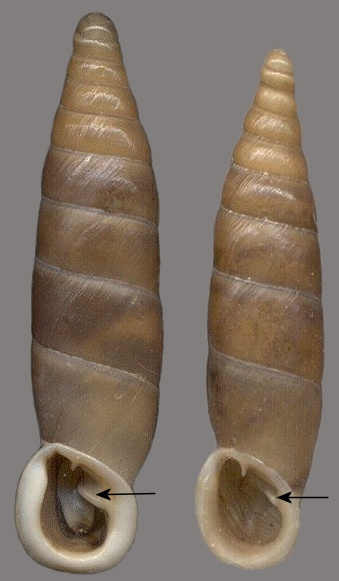|
Salients in distinguishing a pair of similar syntopic
doorsnails |
|
In each panel below there is a pair of apparently left-handed
(the familial norm) clausiliid snail shells. In each case the image
on the left is an unaltered Albinaria
(Isabellaria) lophauchena
(Sturany, 1894), and the one on the right is a mirror image of a
(normally-dextral)
Nymphogena dextrosa (O. Boettger,
1877).
The two were collected together, along with several other
conspecifics, by Maria Demertzis in Greece: Voras Range, Mount Paiko,
Pella Prefecture ca. 29 km SSW Giannitsa, 100 to 200 m. above end of
access road, among limestone rocks along the trail to the peak.
A later sample from this station by Maria totaled 321 specimens. Of
these 259 (80.4%) were sinistral and 62 (19.6%) were dextral. |
|
 |
|
In apertural view A. lophauchena (L) and
N. dextrosa (R) appear quite similar, but the acutely-tapered apex
and small nuclear whorl of the latter is distinctive. Likewise
the more callous
peristome and larger, more
horizontal "inferior lamella" [columellar fold; see arrows] of the former seem consistent rather
than an ontogenetic (developmental) artifact of
greater maturity. |
 |
|
The dorsal view reveals substantial differences. The
axial fold (lunella) A. lophauchena (L) is weakly sigmoid,
whereas that of the mirror-imaged N. dextrosa (R) appears to
have a rectangular flexure (actually due to fusion with a spiral
lamella) making a pattern like the number "7" [horizontal arrows].
The spiral lamellae [vertical arrows] are poorly developed in A.
l. while the "principal plica" of N. d. is extremely
long, actually spanning half the body whorl and being clearly
visible within the aperture. The ridge (crista) on the body whorl of
A. l. is much more well-developed, is somewhat sinuous, and
lies oblique to the shell axis (opisthocline) vs. the straighter
coaxially-oriented crista of S. d. [oblique arrows]. |
|
 |
|
In these lateral views [left-lateral for the sinistral A.
lophauchena (L) and right-lateral (mirrored to appear in the
same orientation) for the dextral N. dextrosa (R)], the
differences in placement of the lunellae (see oblique arrows and
panel immediately above) is evident, but an equally conspicuous
difference is the C-shaped [a backwards-C after mirroring]
subcolumellar lamella [horizontal arrow] just inside the aperture of
N. dextrosa. There is a homologous structure in A.
lophauchena, but it is narrower, straight, and so close to the
aperture that it cannot be seen in this view. |
|
The above conchological terminology conforms to that of Nordsieck
(2007), and the taxonomic treatment follows Schileyko (2000).
Nordsieck, H., 2007. Worldwide Door Snails (Clausiliidae), Recent
and fossil. ConchBooks, Hackenheim, Germany. Pp. 1-214. Oct.
Schileyko, A. A., 2000. Treatise on Recent terrestrial pulmonate
molluscs 5. Clausiliidae. Ruthenica supplement 2: (ii) +
565-729 incl. numerous text figs. May. |
|
 |
|